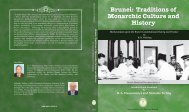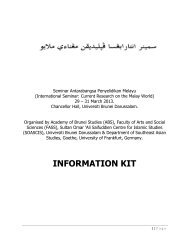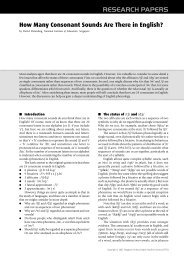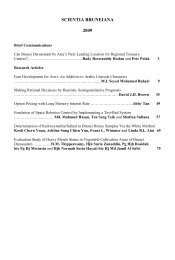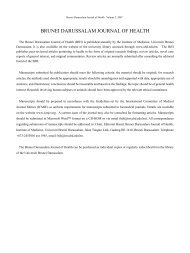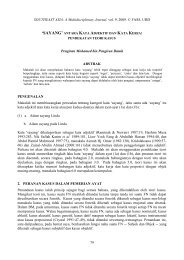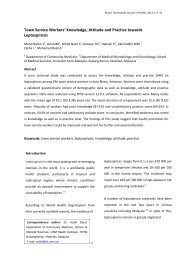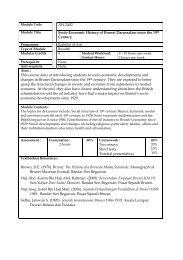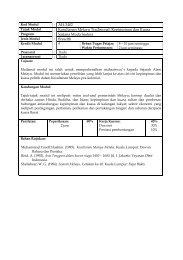cover single page - Universiti Brunei Darussalam
cover single page - Universiti Brunei Darussalam
cover single page - Universiti Brunei Darussalam
Create successful ePaper yourself
Turn your PDF publications into a flip-book with our unique Google optimized e-Paper software.
<strong>Brunei</strong>: Revival of 1906<br />
<strong>Brunei</strong> lands, tulin (private) property, passed from his hands to Sarawak<br />
and the British North Borneo Company. In 1884, he and Sultan Abdul<br />
Mumin transferred to Sarawak all the rivers from Kidurong to Baram in<br />
exchange for a sum of $3,000 and $2,000 a year. In fact, Temenggung<br />
Hashim had offered not only Trusan but also Limbang to Sarawak at the<br />
time. Originally, the Trusan River had been ceded to Sarawak in 1884.<br />
For the Trusan transfer in 1885, he was paid a price of $4,500 per annum.<br />
He transferred the deeds under his own seal and that of the Pengiran<br />
Bendahara, without waiting for the seal of the Pengiran Di-Gadong or<br />
the Sultan. Behind this transfer seemed to have been a political motive of<br />
the Temenggung to become the next <strong>Brunei</strong> Sultan. Charles Brooke, the<br />
Sarawak Rajah, this time countenanced Temenggung Hashim’s claim to<br />
the <strong>Brunei</strong> throne, possibly anticipating not only the confirmation of the<br />
Trusan cession from BNBC to his own country, but also the Limbang.<br />
After becoming the Sultan in June 1885, Hashim Jalilul reneged on his<br />
promise to sell off Limbang and again, was demonised by Brooke (On<br />
12 December 1904, Trusan, together with Lawas District, was finally<br />
transferred to Sarawak ownership).<br />
22<br />
LIMBANG AND THE WOES OF THE SULTAN<br />
The forcible annexation of Limbang in 1890 hardened Sultan Hashim<br />
to make his final stand against all overtures by Britain and Brooke. In<br />
1904 Sultan Hashim was left with only four rivers, having lost no fewer<br />
than 18 such districts to Sarawak alone. With the loss of these lands,<br />
<strong>Brunei</strong> had become abysmally poor. Previously, Sarawak produced<br />
antimony and Mukah produced sago, while Limbang provided subsistence<br />
to the folks in the capital. Now, starvation for both the palace and the<br />
ruler had set in.<br />
With the loss of Limbang, the last of economic opportunities in<br />
the State (if any), had been wiped out. For instance, almost all the four<br />
sago factories in <strong>Brunei</strong> had to be closed down by 1903 as the trade<br />
shifted from Limbang to Kuching. Only the small cutch factory was<br />
operating on the bank of the Kampong Ayer that gave employment to<br />
about 300 men. Its European manager, Edmund Roberts, became a special<br />
friend to the Sultan who expressed his gratitude to the European for<br />
supplying wooden planks to repair the steps of his rickety palace. The<br />
manager, who was secretly conspiring behind the back of the Sultan, not<br />
only became his adviser, but also was given the title of Dato and a seat in<br />
the newly created State Council.



